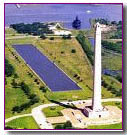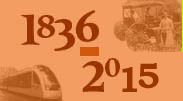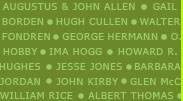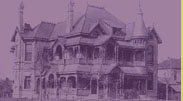LANDMARKS - Parks and Monuments
Parks
Parks are abundant throughout the city and below are a few of the most recognized.
 Sam Houston Park
Sam Houston Park
Opened in 1899 as the first city park, the 20-acre Sam Houston Park is now an outdoor museum containing a permanent exhibition of old Houston homes. The project is sponsored by the Harris County Heritage Society.
Kellum-Noble House
 Nathaniel Kellum's house, a plantation-style house built in 1847, is the oldest brick home in Houston. In 1850, Kellum moved from Houston, selling his home to Abram W. Noble. During the 1850's, Mrs. Zerviah M. Noble and her daughter, Catherine A. Kelly, operated one of Houston's first private schools in the Kellum-Noble house. A second restored home in the park is the San Felipe Cottage, a typical Texas cottage of the 1870's.
Nathaniel Kellum's house, a plantation-style house built in 1847, is the oldest brick home in Houston. In 1850, Kellum moved from Houston, selling his home to Abram W. Noble. During the 1850's, Mrs. Zerviah M. Noble and her daughter, Catherine A. Kelly, operated one of Houston's first private schools in the Kellum-Noble house. A second restored home in the park is the San Felipe Cottage, a typical Texas cottage of the 1870's.
Long Row
 Another park feature is the Long Row reconstruction, a replica of Houston's first shopping strip. Part of the city's bid to become the capital of the Texas Republic, the Long Row construction was hastily put together in 1837. The Long Row housed, among others, R. C. Barry & Company, tailors; A. McGowen, tin, sheet, iron and copper-ware vendor; Cooke & Ewing, druggists and Dick Dowling's Bank of Bacchus saloon. The original structure burned down in 1860.
Another park feature is the Long Row reconstruction, a replica of Houston's first shopping strip. Part of the city's bid to become the capital of the Texas Republic, the Long Row construction was hastily put together in 1837. The Long Row housed, among others, R. C. Barry & Company, tailors; A. McGowen, tin, sheet, iron and copper-ware vendor; Cooke & Ewing, druggists and Dick Dowling's Bank of Bacchus saloon. The original structure burned down in 1860.
Nichols-Rice-Cherry House
 The Nichols-Rice-Cherry house was originally built in 1850 in a Greek Revival Style, for Ebenezer B. Nichols, a native of Cooperstown, New York. William M. Rice owned the house between 1851 and 1863 and Mrs. Emma Cherry saved it from demolition in 1897. In 1957, it was presented to the park by Gus Wortham, an insurance executive.
The Nichols-Rice-Cherry house was originally built in 1850 in a Greek Revival Style, for Ebenezer B. Nichols, a native of Cooperstown, New York. William M. Rice owned the house between 1851 and 1863 and Mrs. Emma Cherry saved it from demolition in 1897. In 1957, it was presented to the park by Gus Wortham, an insurance executive.
Pillot House
 The lumber of the Pillot House, built in 1868 and moved from McKinney Avenue to the park, was chosen by Eugene Pillot, one of the early developers in Houston. It is a mid-Victorian structure with some significant features, including what is considered to be the first inside kitchen in a Houston home.
The lumber of the Pillot House, built in 1868 and moved from McKinney Avenue to the park, was chosen by Eugene Pillot, one of the early developers in Houston. It is a mid-Victorian structure with some significant features, including what is considered to be the first inside kitchen in a Houston home.
Old Place
 Other Structures in the park include the Old Place, a cabin built by John W. Williams (an Austin Colonist) on the banks of Clear Creek about 1824, which is the oldest structure in Harris County.
Other Structures in the park include the Old Place, a cabin built by John W. Williams (an Austin Colonist) on the banks of Clear Creek about 1824, which is the oldest structure in Harris County.
St. John Church
 St. John Church, an Evangelical Lutheran Church, built in 1891; the Spirit of the Confederacy statue placed in the park by the Daughters of the Confederacy; and the Sam Houston Park bandstand, a replica of the original turn-of-the century "Houston City Park" bandstand.
St. John Church, an Evangelical Lutheran Church, built in 1891; the Spirit of the Confederacy statue placed in the park by the Daughters of the Confederacy; and the Sam Houston Park bandstand, a replica of the original turn-of-the century "Houston City Park" bandstand.
Hermann Park
The 545-acre Hermann Park, which contains the zoo and public recreational facilities, was named for George Hermann, an affluent Houstonian who, in 1914, donated the land for the park.  Located in it is the log house headquarters of the Daughters of the Republic of Texas, San Jacinto Chapter. Reminiscent of the early log houses in Houston, the stones for the fireplace come from historic old homes throughout Texas. In another part of the park stands a statue of General Sam Houston, which was unveiled in August, 1925. Besides this, it was George Hermann who also donated land in the present City Hall area for a public square. The one stipulation he made was that anybody who might wish to do so could sleep there "undisturbed by the forces of law and order."
Located in it is the log house headquarters of the Daughters of the Republic of Texas, San Jacinto Chapter. Reminiscent of the early log houses in Houston, the stones for the fireplace come from historic old homes throughout Texas. In another part of the park stands a statue of General Sam Houston, which was unveiled in August, 1925. Besides this, it was George Hermann who also donated land in the present City Hall area for a public square. The one stipulation he made was that anybody who might wish to do so could sleep there "undisturbed by the forces of law and order."
Memorial Park
 Memorial Park is a municipal park that is one of the largest urban parks in the United States. The park contains the Houston Arboretum and botanical gardens and numerous recreational facilities. Opened in 1924, the park covers approximately 1,466 acres inside the 610 Loop, across from the neighborhood of Memorial. Memorial Drive runs through the park, heading east to downtown Houston and west to the 610 Loop. I-10 borders the park to the north. The park was originally designed by landscape architects Hare & Hare of Kansas City, Missouri.
Memorial Park is a municipal park that is one of the largest urban parks in the United States. The park contains the Houston Arboretum and botanical gardens and numerous recreational facilities. Opened in 1924, the park covers approximately 1,466 acres inside the 610 Loop, across from the neighborhood of Memorial. Memorial Drive runs through the park, heading east to downtown Houston and west to the 610 Loop. I-10 borders the park to the north. The park was originally designed by landscape architects Hare & Hare of Kansas City, Missouri.
From 1917 to 1923, the land where the park currently exists was the site of Camp Logan, a World War I US Army training camp. During wartime, the training camp was located on the far west boundaries of Houston. After the war in early 1924, Will and Mike Hogg, purchased 1,503 acres of former Camp Logan land and sold the area to the city at cost. In May 1924, the City of Houston took ownership of the land to be used a "memorial" park dedicated to the memory to the soldiers who lost their life serving in World War I. The park is adjacent to the Camp Logan, Crestwood, and Rice Military neighborhoods.
 Allen's Landing Park
Allen's Landing Park
Named for the founders of Houston, the Allen brothers, Allen's Landing Park is situated on Buffalo Bayou at Main Street. This is where the Allen's first set foot in the area that would become the city of Houston and where they built their original trading post. Undertaken as a Bicentennial Project by the city, Allen's Landing is a historical theme park.
Tranquility Park
 Tranquility Park, designed by Charles Tapley and dedicated on the tenth anniversary for the first lunar landing, is a tribute to man's achievements in space travel. Neil Armstrong's words, transmitted from the moon, "Houston, Tranquility base here. The Eagle has Landed." are written in many languages on plaques placed at the entrance to the park. The mounds and depressions on the parks surface represent the cratered lunar surface.
Tranquility Park, designed by Charles Tapley and dedicated on the tenth anniversary for the first lunar landing, is a tribute to man's achievements in space travel. Neil Armstrong's words, transmitted from the moon, "Houston, Tranquility base here. The Eagle has Landed." are written in many languages on plaques placed at the entrance to the park. The mounds and depressions on the parks surface represent the cratered lunar surface.
 Discovery Green Park
Discovery Green Park
Discovery Green, a 12-acre park located in downtown Houston, opened on April 13, 2008. With its proximity to the George R. Brown Convention Center, Minute Maid Park and Toyota Center, Discovery Green is an ideal location for the city's newest attraction.
Monuments
San Jacinto Battleground and Monument
 The State of Texas erected a fitting monument to her heroes in the construction of the historic San Jacinto Battleground and Monument, which is located about twenty miles southeast of Houston. In the year 1836, Texas gained her independence in a decisive victory over the Mexican forces led by General Santa Anna. The San Jacinto Monument, rising 570 feet above the battleground, stands as a memorial to the brave men who fought for Texas independence. Built to commemorate the centennial of the battle, it is the tallest masonry structure in the world. The San Jacinto Museum of History is at the base of the tower. Its exhibits provide an overview of 400 years of Texas history.
The State of Texas erected a fitting monument to her heroes in the construction of the historic San Jacinto Battleground and Monument, which is located about twenty miles southeast of Houston. In the year 1836, Texas gained her independence in a decisive victory over the Mexican forces led by General Santa Anna. The San Jacinto Monument, rising 570 feet above the battleground, stands as a memorial to the brave men who fought for Texas independence. Built to commemorate the centennial of the battle, it is the tallest masonry structure in the world. The San Jacinto Museum of History is at the base of the tower. Its exhibits provide an overview of 400 years of Texas history.
Cemeteries
Like most large cities, Houston has a number of cemeteries just outside of downtown in areas that were, at one time, the outskirts.
 Founders' Memorial Cemetery
Founders' Memorial Cemetery
The grave of John Kirby Allen, who died shortly after helping found the city, lies in Founders' Memorial Cemetery, on West Dallas and Valentine. The cemetery was renovated in 1936 by the State of Texas as part of the state's centennial celebrations.
Glenwood Cemetery
 Glenwood Cemetery was the first in the city to be professionally designed in 1871. Landscape artist Alfred Whitaker was brought in from England for the job. He molded the cemetery around the undulating hills thrown up by Buffalo Bayou floods.
Glenwood Cemetery was the first in the city to be professionally designed in 1871. Landscape artist Alfred Whitaker was brought in from England for the job. He molded the cemetery around the undulating hills thrown up by Buffalo Bayou floods.
Today, Glenwood is a peaceful place for families, the bereaved, and the merely curious to reflect on the monuments and the fact that the best views of Houston's skyline are reserved for the dead. It is worth a few hours to wander through the twisting lanes to see the sculptures, the soaring obelisks, and the historic markers.
Some of Houston's most famous citizens can be found in Glenwood Cemetery, one of the oldest graveyards in town. The cemetery's most famous resident is Howard R. Hughes, Jr, Aviator, Industrialist and reclusive billionaire. His grave lies in a fenced-off family plot that includes Howard R. Hughes, Sr., Co-founder, Sharp-Hughes Tool Company, later renamed Hughes Tool Company, and wife. It is hard to spot because the marker is flush with the ground.
Below there are more names of Houston's greatest citizens that also chose Glenwood Cemetery for their final resting place. Anson Jones, the last president of the Republic of Texas (1844-1845); Thomas Lubbock, commander of the Terry Rangers; James Holman, one of the early mayors of Houston. Joseph S. Cullinan, Founder of Texaco; William Stamps Farish II, Co-founder, Humble Oil Company; Albert Bel Fay, U.S. Ambassasor to Trinidad and Tobago; Maria "Ria" Franklin Prentiss Lucas Langham Gable, Texas socialite, married to Clark Gable (1931-1939); James Wilson Henderson, Governor of Texas (1853); Oveta Culp Hobby, U.S. Secretary, Department of Health, Education and Welfare (1953-1955); William P. Hobby, Governor of Texas 1917-1921; Roy Hofheinz, Father of the Astrodome; Edgar Odell Lovett, President (1st), Rice University 1912-1946; Glenn McCarthy, "King of the Wildcatters and wife Faustine; Hiram Runnels, Governor of Mississippi 1833-1835; Walter Benona Sharp, Co-founder, Sharp-Hughes Tool Company, later renamed Hughes Tool Company; Ross S. Sterling, Governor of Texas (1931-1933); Co-founder, Humble Oil Company;
Gene Tierney, Hollywood Actress; Margaret Kinkaid, founder of The Kinkaid School in Houston's Piney Point area
Washington Cemetery
(formerly Deutsche Gesellschaft von Houston cemetery)
 In 1887 a group of local German businessmen formed an association called the Deutsche Gesellschaft, for the purpose of establishing a cemetery for the German citizens of the Houston area. They purchased this tract, then located outside the city limits, from the heirs of John Lawrence and Thomas Hart. Until 1918 the burial site was known as the German Society Cemetery. The name was changed to Washington Cemetery because of anti-German sentiment during World War I. The earliest burials after the founding of the cemetery occurred on March 20, 1887, when J. Turner and Annie Fraser were interred here. One section with forty-two gravesites was set aside for the burial of Confederate veterans of the Civil War by members of the Dick Dowling Camp. No. 197, UCV. Emma (Edmondson) Seelye (1841-1898), also a veteran of the Civil War, is buried here. Masquerading as a man and using the name Frank Thompson, she enlisted in the Federal army in 1861. For two years she served as a soldier, scout, brigade postmaster, and orderly on the staff of General O. M. Poe. She left the unit in 1863 after contracting malaria, but later served in the war as a nurse. She died near La Porte, Texas.
In 1887 a group of local German businessmen formed an association called the Deutsche Gesellschaft, for the purpose of establishing a cemetery for the German citizens of the Houston area. They purchased this tract, then located outside the city limits, from the heirs of John Lawrence and Thomas Hart. Until 1918 the burial site was known as the German Society Cemetery. The name was changed to Washington Cemetery because of anti-German sentiment during World War I. The earliest burials after the founding of the cemetery occurred on March 20, 1887, when J. Turner and Annie Fraser were interred here. One section with forty-two gravesites was set aside for the burial of Confederate veterans of the Civil War by members of the Dick Dowling Camp. No. 197, UCV. Emma (Edmondson) Seelye (1841-1898), also a veteran of the Civil War, is buried here. Masquerading as a man and using the name Frank Thompson, she enlisted in the Federal army in 1861. For two years she served as a soldier, scout, brigade postmaster, and orderly on the staff of General O. M. Poe. She left the unit in 1863 after contracting malaria, but later served in the war as a nurse. She died near La Porte, Texas.






